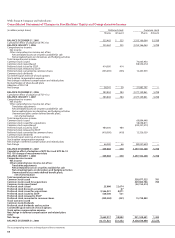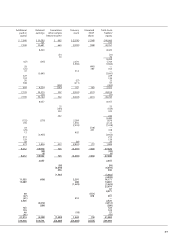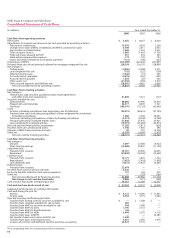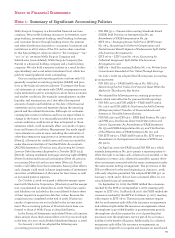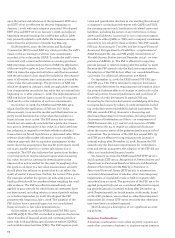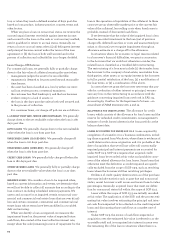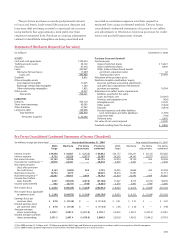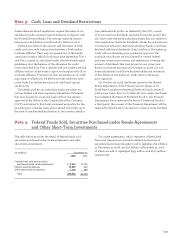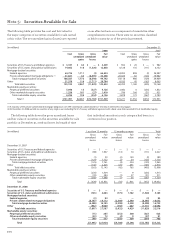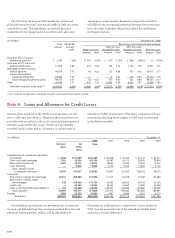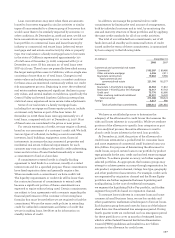Wells Fargo 2008 Annual Report Download - page 100
Download and view the complete annual report
Please find page 100 of the 2008 Wells Fargo annual report below. You can navigate through the pages in the report by either clicking on the pages listed below, or by using the keyword search tool below to find specific information within the annual report.
Premises and Equipment
Premises and equipment are carried at cost less accumulated
depreciation and amortization. Capital leases are included in
premises and equipment at the capitalized amount less accu-
mulated amortization.
We primarily use the straight-line method of depreciation
and amortization. Estimated useful lives range up to 40 years
for buildings, up to 10 years for furniture and equipment, and
the shorter of the estimated useful life or lease term for lease-
hold improvements. We amortize capitalized leased assets on
a straight-line basis over the lives of the respective leases.
Goodwill and Identifiable Intangible Assets
Goodwill is recorded in business combinations under the pur-
chase method of accounting when the purchase price is high-
er than the fair value of net assets, including identifiable
intangible assets.
We assess goodwill for impairment annually, and more
frequently in certain circumstances. We assess goodwill for
impairment on a reporting unit level by applying a fair-value-
based test using discounted estimated future net cash flows.
Impairment exists when the carrying amount of the goodwill
exceeds its implied fair value. We recognize impairment loss-
es as a charge to noninterest expense (unless related to dis-
continued operations) and an adjustment to the carrying
value of the goodwill asset. Subsequent reversals of goodwill
impairment are prohibited.
We amortize core deposit and other customer relationship
intangibles on an accelerated basis based on useful lives not
exceeding 10 years. We review such intangibles for impair-
ment whenever events or changes in circumstances indicate
that their carrying amounts may not be recoverable.
Impairment is indicated if the sum of undiscounted estimated
future net cash flows is less than the carrying value of the
asset. Impairment is permanently recognized by writing
down the asset to the extent that the carrying value exceeds
the estimated fair value.
Operating Lease Assets
Operating lease rental income for leased assets is recognized
in other income on a straight-line basis over the lease term.
Related depreciation expense is recorded on a straight-line
basis over the life of the lease, taking into account the esti-
mated residual value of the leased asset. On a periodic basis,
leased assets are reviewed for impairment. Impairment loss is
recognized if the carrying amount of leased assets exceeds
fair value and is not recoverable. The carrying amount of
leased assets is not recoverable if it exceeds the sum of the
undiscounted cash flows expected to result from the lease
payments and the estimated residual value upon the eventual
disposition of the equipment. Leased assets are written down
to the fair value of the collateral less cost to sell when 120
days past due.
Pension Accounting
We account for our defined benefit pension plans using an
actuarial model required by FAS 87, Employers’ Accounting
for Pensions, as amended by FAS 158, Employers’ Accounting
for Defined Benefit Pension and Other Postretirement Plans –
an amendment of FASB Statements No. 87, 88, 106, and 132(R).
This model allocates pension costs over the service period of
employees in the plan. The underlying principle is that
employees render service ratably over this period and, there-
fore, the income statement effects of pensions should follow a
similar pattern.
FAS 158 was issued on September 29, 2006, and became
effective for us on December 31, 2006. FAS 158 requires us to
recognize the funded status of our pension and postretire-
ment benefit plans on our balance sheet. Additionally, FAS
158 requires us to use a year-end measurement date begin-
ning in 2008. We conformed our pension asset and our pen-
sion and postretirement liabilities to FAS 158 and recorded a
corresponding reduction of $402 million (after tax) to the
December 31, 2006, balance of cumulative other comprehen-
sive income in stockholders’ equity. FAS 158 does not change
the amount of net periodic benefit expense recognized in our
income statement.
One of the principal components of the net periodic pen-
sion expense calculation is the expected long-term rate of
return on plan assets. The use of an expected long-term rate
of return on plan assets may cause us to recognize pension
income returns that are greater or less than the actual returns
of plan assets in any given year.
The expected long-term rate of return is designed to
approximate the actual long-term rate of return over time and
is not expected to change significantly. Therefore, the pattern
of income/expense recognition should closely match the stable
pattern of services provided by our employees over the life of
our pension obligation. To ensure that the expected rate of
return is reasonable, we consider such factors as (1) long-term
historical return experience for major asset class categories
(for example, large cap and small cap domestic equities,
international equities and domestic fixed income), and
(2) forward-looking return expectations for these major asset
classes. Differences between expected and actual returns in
each year, if any, are included in our net actuarial gain or loss
amount, which is recognized in other comprehensive income.
We generally amortize any net actuarial gain or loss in
excess of a 5% corridor (as defined in FAS 87) in net periodic
pension expense calculations over the next five years.
We use a discount rate to determine the present value of
our future benefit obligations. The discount rate reflects the
rates available at the measurement date on long-term high-
quality fixed-income debt instruments and is reset annually
on the measurement date. In 2008, we changed our measure-
ment date from November 30 to December 31 as required
under FAS 158.
Income Taxes
We file consolidated and separate company federal income
tax returns, foreign tax returns and various combined and
separate company state tax returns.
We account for income taxes in accordance with FAS 109,
Accounting for Income Taxes, as interpreted by FASB


